Sony Cyber-shot DSC-HX1 Overview
Reviewed by Mike Pasini and Stephanie Boozer
Review Date: 09/30/09
Review Date: 09/30/09
The Sony Cyber-shot DSC-HX1 is the company's first digital camera to be based around its new high-speed 1/2.4-inch 9.1-megapixel EXMOR CMOS image sensor. The sensor is coupled to a Sony G-branded 20x optical zoom, offering a whopping range from a useful 28mm wide angle to a far-reaching 560mm telephoto equivalent. Macro shooting is possible to as close as just 0.4 inches (one centimeter). Sony includes its Optical SteadyShot image stabilization, as you'd expect on a camera with a lens this powerful. The Sony HX1 offers ISO sensitivities from 125 to 3,200 equivalent at full resolution.
The big story of the Sony DSC-HX1's imager is its speed: It's capable of up to ten frames per second at full resolution using a mechanical shutter rather than an electronic one, to prevent image distortion. The Sony HX1 uses this speed to offer two interesting modes that aim to reduced blur in images. Both the hand-held twilight mode and anti-motion blur mode capture six images in a short burst and then combine them into a single image with the maximum possible sharpness and reduced noise. The difference between the two is that the latter mode creates the background from the entire group of images, and then overlays the main subject from one image only onto this background. Another mode that takes advantage of the Sony HX1's speed is the "Sweep Panorama," which captures up to 224-degree horizontal or 154-degree vertical panoramas with a single press of the Cybershot HX1's shutter button. Simply "sweep" the camera across your subject while holding the shutter button, and the images are automatically captured at high-speed and stitched together into a single panorama.
The Sony HX1's focusing is achieved using contrast detection. The Sony HX1 also includes face detection functionality, linked to the autofocus, autoexposure, white balance and flash systems. The face detection function is also used for a Smile Shutter mode which triggers the shutter when your subject smiles, and has the ability to differentiate between adult / child faces and to memorize and recognize one specific individual's face -- which can then be prioritized whenever the Sony HX1 identifies it in a photo.
For photographers wanting maximum ease of use, the Sony Cybershot HX1 offers a selection of twelve scene modes, and a Scene Recognition mode which can detect the subject and then automatically select the relevant option from a subset of eight common scene modes. If you desire a little more control over the creative process, the Sony Cyber-shot DSC-HX1 also offers both Aperture- and Shutter-priority modes as well as the ability to shoot completely manually, specifying your own choice of shutter speed and aperture.
Sony HX1 owners can frame and review their images and movies either on the camera's 201,000-dot electronic viewfinder, or on a 3-inch tiltable LCD display with 230,000 dot resolution. Movie resolutions up to a mighty 1080p high definition (1440 x 1080 pixels) with stereo sound are available, with a frame rate of 30 fps and MPEG-4 AVC / H.264 compression. Images are stored on Memory Stick Duo or PRO Duo cards, or in 11MB of built-in memory. Power is provided by a proprietary InfoLithium H rechargeable battery.
The Sony HX1 goes on sale in the USA from April 2009, priced at about US$500.
Sony HX1 User Report
by Mike Pasini
I've had more fun than usual this summer as I shot with three super long zooms, the 24x Kodak Z980, the 20x Canon SX1 IS and the 20x Sony HX1. They each have their virtues and vices but as the sun set in the Pacific, one stood out: The Sony HX1.
The problems any long zoom has to address are not trivial:
- A sharp electronic viewfinder to see what's going on in bright sun and at long focal lengths
- A responsive shutter at long focal lengths where autofocus tends to fumble around badly
- Good handling so you can actually track a distant object with one of these lightweight bridge cameras
It isn't easy to test this when you're in the store, but problems in any of these areas are immediately apparent in the field. Sometimes I thought even the birds knew which cameras couldn't track them and mocked them by hopping around more than usual.
And yet this Summer's super long zooms seem to have a better handle on all three of those issues than any of the 18x zooms of the past.
And still the Sony HX1 stood out. I took it to more events, shot more images, captured more movies, played it all back on more devices and had more fun with the Sony HX1.
One reason was because I really liked shooting with two of its unique features: the sweep panorama mode and the 10 frames per second release mode. But there were a lot of others.
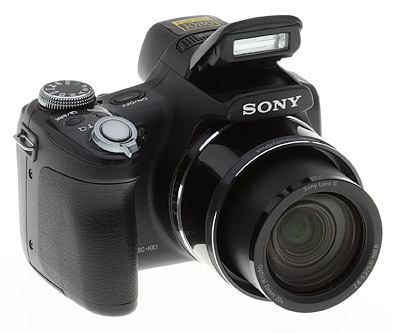
Look and Feel. Of the three super long zooms I tested this summer, the Sony HX1 is probably both the smallest and lightest thanks to Sony's decision to forego the usual four AA batteries tucked into the grip for a lithium-ion cell.
And because you'll want to travel with the Sony HX1, the lithium-ion choice has the advantage of requiring you to bring just a very compact, folding prong charger rather than the corded AA chargers the other cameras require.
The Sony HX1 wasn't so small, though, that I preferred a wrist strap. I did use one for a while with no issues, but most of the time I was hiking with the Sony HX1. I wanted it available but not monopolizing my hands (which I use to balance myself as I cross creek beds and jump from peak to peak). So a shoulder strap was the ticket and I simply attached an UPstrap I had here. It was a very nice, lightweight combination.
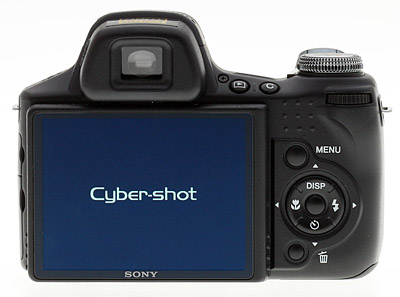
It isn't so small it doesn't give you a healthy handful of a grip either. The Sony HX1's grip was big enough that there was plenty of room for my fingers to wrap securely around it. And that helped provide good stability for those very long focal length shots I was always tempted to take.
One of the smaller touches I appreciated was the lens cap. Long zooms can't cover their glass like an ultracompact digicam so a cap is inevitable. But some of them are just a nuisance to take off and put back on. And others are, well, not. The Sony HX1 has a nice pinch design that even a 90 lb. weakling can handle one handed. And it pops right back on, too, with a snap. There's no lanyard to tether it to the camera, but I didn't mind.
Another small touch I appreciated was the decision to move the octopus plug from underneath the camera to the side. On Sony's past units, which have the plug on the bottom, you have to put the camera face down on a table to connect it to a computer or TV. That's not a great idea with a long zoom, so Sony put the Sony HX1's plug on the left side.
And in another brilliant move, the Sony HX1 includes an HDMI adapter so you can simply grab the end of an HDMI cable attached to your TV and plug it into the adapter to watch your still and video on HDTV. I did that a lot and enjoyed it very much.
What I didn't appreciate very much was the trend toward piano black glossy finishes that Sony can't seem to avoid. The Sony HX1, like the Alphas, has this on the top of the grip, and on the lens barrel as well. It makes the gear look like cheap plastic, not a Steinway, and I wish designers would move away from it and back to the rubberized matte finishes that are not only more useful but less reflective.
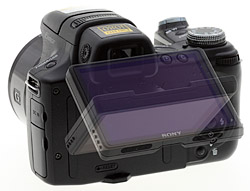
While the LCD is an articulated design, it doesn't move much. The articulation allows you to swing the LCD up so it's perpendicular to the camera, allowing you to put the camera on the ground and still see what's going on. It also allows you to swing it down so it's perpendicular to the Sony HX1, so you can hold it directly over your head in a crowd.
You can't swing it sideways, but there's a funny thing about that. The cameras that do have LCDs that swing sideways were so awkward that I ended up just closing them in the traditional position on the back. And the two really important positions an articulated LCD provide are low and high camera positions. So I articulated this LCD more than any other.
Sony is the one camera manufacturer without a button for its popup flash. The Sony HX1's flash simply pops up as required all on its own.
Controls. I have no complaints about the control layout on the Sony HX1. It was easy to find everything, mostly because everything was where it usually is.
On the top panel the large Shutter button is ringed by the Zoom control, just the way I like it. Behind it on the grip's top deck are two very useful buttons: the Focus button and the Release mode button.
Having the Focus button by the Shutter button on a long zoom is a brilliant idea because at long focal lengths, you can often avoid the nuisance of autofocus and just manually set the camera to focus at infinity.
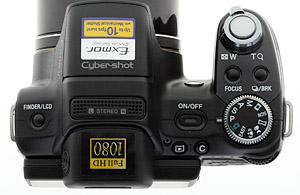
On the Sony HX1, having the Release mode button up there, too, is brilliant because that's how you get the camera to fire the shutter at 10 fps. Having buttons dedicated to the special features is SLR-like, really, and much appreciated.
Behind those two buttons is the large, knurled Mode dial which makes it easy to access the sweep panorama feature as well as the manual settings, the intelligent Auto mode, Easy mode, Scene modes, and Movie mode.
To the left of the Mode dial is the elongated and recessed Power button. Power buttons tend to be the least well-designed part of any camera, but the Sony HX1's Power button was not a problem.
You can also power the camera on but not off with the Playback button. That's not good design. Whenever we pressed Playback to turn the camera off (which is good design), the lens would extend, knocking off the cap. You have to use the Power button to turn the camera off from Playback mode.
Just behind the Power button on something of a sloping ledge are the Playback button and the Custom button. The Custom button can be set in the Setup screen to function as Smile Shutter, White Balance, or Metering Mode. None of that was particularly compelling to me, so I left it at the default Smile Shutter.
The electronic viewfinder (EVF) has a hard plastic frame, not particularly friendly to eyeglasses (although I didn't scratch mine), with a dioptric adjustment on the left side that was easy to use. The EVF itself was the best I've used. At first I didn't realize it was electronic. The resolution is very high and it's very bright. A small button on the top deck to the left of it switches between the EVF and the LCD, just as you would expect.
The 3-inch LCD with 230K pixels sports an anti-reflective screen that worked fine in bright sun.
To the right of the LCD on the back panel, the four-way navigator with an OK button in the middle sits between the Menu button on the top left and the Delete button on the bottom left. The four arrow keys also access Display options from the Up arrow, Flash settings from the Right arrow, Self-timer options from the Down arrow, and Macro options from the Left arrow.
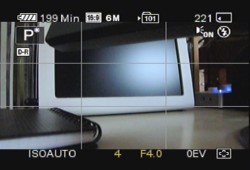
On Screen Controls. Use the jog dial to move between ISO, Shutter/Aperture and EV in Programmed Auto. Press to select the highlighted control, dial in the new value, press to confirm.
The Sony HX1 has an Auto Macro default setting but you can force it to shoot in Macro mode (speeding things up a tiny bit) using the Macro option.
There's one more control on the Sony HX1 and it's really the most important. It's the jog dial in the top right corner of the back panel, just behind the Mode dial. I'm usually very appreciative of a command dial there and a jog dial is just a command dial that can double click, so to speak. But this jog dial was a little too racy for me. I found it hard to control.
And I needed to control it a lot. In the PASM modes, you use it to scroll to and pick a settable option, fly through the settings, and finally select one. I was always moving off my setting accidentally before I could press the jog dial in to fix it or madly dialing when I should have jogged to move to a different setting.
It's a great concept, no argument there, but it didn't work as well in practice as I would have liked. Since I had to rely on it alone to set the aperture, shutter speed, EV or ISO, it plays a major role in how the camera responds.
Lens. The Sony HX1 does not have a Vario-Tessar lens like most Sony cameras. Instead, it has a G lens. Sony explains that "G lenses are used in top of the line digital single lens reflex (DSLR) cameras and advanced pro-sumer HD Camcorders" because they are "optimized to perfectly complement the advanced image sensors and image processing technology in Sony's cameras."
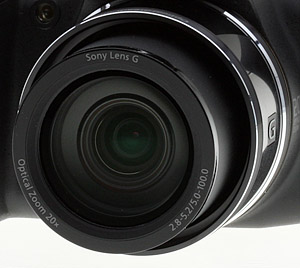
The Sony HX1's G lens has a six-blade aperture designed to produce superior bokeh (defocused backgrounds) and its aspherical lens elements are made of ED glass to minimize chromatic aberration.
Its 20x zoom range starts at a wide 28mm (in 35mm equivalent) and reaches optically to 560mm for stills. The video equivalent is a bit different, ranging from 31-620mm for 16:9 and 38-760 for 4:3.
The lens zooms in discrete steps at slow speed if you gently press the Zoom control and faster if you press the control all the way. So you do have some control over your composition, although it isn't quite as fine as I'd like.
Aperture ranges from f/2.8 to f/8.0 at wide angle. At telephoto it's f/5.2 to f/8.0. Shutter speeds range from two minutes to 1/4,000 second in Auto and as much as 30 minutes and 1/4,000 second in Manual and Shutter priority modes. Aperture priority mode is restricted, if you can call it that, to eight minutes and 1/2,000 second).
With 2x digital zoom, the Sony HX1 can reach 1,250mm at 40x with what the company calls Precision Zoom, but Sony also provides a Smart Zoom option that restricts zoom (and maintains image quality) to the file size. With a 5-Mp image size, total zoom is 26x, at 3-Mp it's 33x and at VGA it's 108x.
The Sony HX1 also enjoys (and requires) Sony's SteadyShot optical image stabilization technology. It can be deployed when the shutter is pressed or full time and it can be disabled.
Sensor Technology. Sony uses Exmor CMOS sensors is both its digital cameras and camcorders. And on the digital camera side of things, you'll find it in Sony's Alpha dSLRs and digicams like the HX1.
Key to the technology is its noise reduction and analog-to-digital conversion -- both of which occur on the sensor itself. Noise reduction is applied to the raw sensor data both before and after the on-chip column analog-to-digital conversion resulting in a cleaner digital signal, according to Sony.
Because noise is suppressed on the sensor, which delivers digital data rather than analog data that must be converted, the Bionz processor has less work to do and can keep up with the demands of HD video recording. It also performs Raw data noise reduction, image processing and data compression.
Modes. There seem to be more modes on the Sony HX1 than any camera I remember. And every one of them is handy.
Programmed Auto actually lets you shift not just the EV setting to darken or lighten exposure but the range of acceptable shutter speed/aperture combinations for any given exposure. Many P modes just let you tinker with the EV setting.
Aperture and Shutter priority let you control either of those critical variables. And Manual mode lets you control both of them independently. I'm always delighted to see them and really wouldn't buy a camera without them.
Intelligent Auto can recognize several Scenes automatically, relying on Sony's Face Detection technology, SteadyShot optical image stabilization and intelligent scene recognition to optimize camera conditions for each situation. Intelligent Scene recognition itself can detect Backlight, Backlight Portrait, Twilight, Twilight Portrait, Twilight using a Tripod, Portrait, Landscape, and Macro situations and set the camera in 1/30 second. The Advanced option takes a second photo in dark or backlit scenes so you can choose between standard and optimized shots.
We've already explained how Easy mode restricts the options you (or more likely your bumbling relative or inquisitive child) can fiddle with.
Handheld Twilight mode captures six images with one press of the Shutter button, combining them into one optimized image with 50 percent less noise than otherwise.
Anti-Motion Blur mode uses the speed of the Exmor CMOS sensor's high ISO and the power of the Bionz image processor to detect subject movement and camera shake to set the ISO to avoid blur from subject movement or camera shake. As in Handheld Twilight mode, six images are taken and composited to create an optimized image with 50 percent less noise.
Sweep Panorama mode creates a panoramic image in the camera of up to 224 degrees with a single press of the Shutter button and either a horizontal or vertical sweep of the lens across the scene.
Scene modes include High Sensitivity, Landscape, Soft Snap, Advanced Sports Shooting, Twilight Portrait, Twilight, Beach, Snow, Fireworks, and Gourmet.
1080 HD Video. An 8MB file lasting 6 seconds with 20x zoom and stereo sound. 720 and VGA sizes are also available, all at 30 fps. (Be aware that not all computers can play HD video files.) Click image to download/play the file.
Movie mode options are extensive, offering a choice between Auto and High Sensitivity, image size (1440 x 1080 Fine, 1440 x 1080 Standard, 1280 x 720, and VGA; all at 30 fps), White Balance settings, Metering modes, Color modes, and SteadyShot on/off. Sound is captured with the built-in stereo microphone behind the pop-up flash. And the 20x zoom is available. The Sony HX1 uses high quality, high compression MPEG4 AVC/h.264 format with a maximum recording time per clip of 29 minutes.
Menu System. The Sony HX1's Menu system is a hierarchy of context-sensitive settings. The three main contexts are Recording, Playback, and Setup.
In Record mode, the Menu button takes you to a list of settings that varies with the particular recording mode selected on the Mode dial. In Easy mode, for example, options are limited to the Image Size and Flash settings. In the Sony HX1's Program mode, however, options include White Balance, Metering Mode, Bracket Set, Smile Detection Sensitivity, Face Detection, Flash Level, Red Eye Reduction, DRO (dynamic range optimization), Noise Reduction, Color Mode, Color Filter, Color Saturation, Contrast, Sharpness, and SteadyShot.
In Playback, the options include Slideshow, Date List, View Mode, Filter by Faces, Add/Remove Favorites, Display Burst Group, Retouch, Multi-Purpose Resize, Delete, Protect, DPOF, Print, and Rotate.
Finally, the Sony HX1's Settings options are organized into five categories: Shooting, Main, Memory Stick Tool, and Clock Settings. These settings control general camera behavior you won't want to change very frequently. Both the Record and Playback menus include an option to switch to the Settings menu.
The Shooting options, for example, include whether to display grid lines or which flavor of digital zoom to use. You can also enable a two-second Auto Review and save the image's orientation information with the image, among others. And you can set the Flash Sync timing to front or rear curtain.
In another change from its long-standing practice (and one we never failed to gripe about), Sony's menu options now wrap, so if you come to the end of the line in Image Sizes, say, pressing the same navigator key once more takes you to the beginning. You don't run into a brick wall.
The Sony HX1's menu system bothered me much less than previous Sony menu systems. The jog dial goes a long way in moving frequently accessed options out of the menu system and onto the camera -- a great improvement.
Battery & Storage. Unlike most long zooms, the Sony HX1 is powered by a lithium-ion battery rather than a set of four AA batteries. The more compact and lightweight NP-FH50 lithium-ion battery is a type H 6.8 volt cell with a capacity of 195 minutes or 390 images, according to Sony. The company does not report CIPA numbers. The camera reports the number of minutes remaining on the charge in the LCD display.
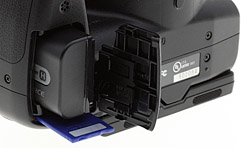
Sony offers three compatible AC adapters for the HX1, including a $50 portable adapter, $70 car adapter and $130 adapter/charger.
With 11MB of internal memory, the Sony HX1 primarily stores images on Memory Stick Duo or PRO Duo cards. It supports up to 16GB Memory Stick DUO Pro media capacity but does not support Access Control security function.
Shooting. For some reason, I haven't seen a lot of birds hanging around the place lately. So, escaping the summer fog, I headed south for Coyote Point and a little sunshine. There was no chance to read the manual to see what was special about the Sony HX1. I was just going to take some ordinary photographs.
I do have to say that the first setting I changed on the Sony HX1 (apart from a reset to defaults and the time, which I always do), was the beep. It was embarrassingly loud even at its lowest setting. So I just shut it off. Then I took off.
Birds may have been scarce but at Coyote Point airplanes fly overhead on their approach to SFO every few ticks of the clock. They're big and slow enough to track, perfect for a long zoom. All I had to do was find them in the sky.
Had I been more familiar with the camera, I would have used a smarter approach than just point and shoot. But that approach worked. I had fun finding the planes and taking shots that ranged from long zoom to full digital zoom.
The one thing that was clearly not a problem was shutter lag. The sensitive Shutter button responded quickly to my press and I got the shot I had framed. But the lightness of the camera body itself often meant the image wasn't quite aligned the way I hoped. It can be hard to frame the subject in the middle of the frame at long focal lengths but pressing the Shutter button often caused the subject to jump to the top of the frame.
The Sony HX1 has a nice workaround for this with its 10 fps Release mode. If you hold down the Shutter button, the HX1 will capture full resolution images at 10 fps for up to 10 frames. That gives you time to recover from the button press and reframe the image.
While 10 fps is quite a bit better than the typical 3-5 fps, it's nowhere near the 40 fps the Casio FH20 can do. But 40 fps is quite a bit faster than the 30 fps of Movie mode (there isn't much you're missing), just to put this in perspective.
The other issue with long focal length shooting is autofocus. I always half-press the Shutter button to see what I'm framing anyway, so the lens wasn't searching interminably for focus. But it's much easier to just set the lens on infinity in Manual focus mode by pressing the Focus button behind the Shutter button.
Those two tricks would have gotten me even better airplane trophies.
There's a small marina at Coyote Point and a beach on the other side of the point, too. I took a few scenic shots of the boats docked at the marina and then tried to follow the action on the bay with the wind surfers, particularly in Movie mode.
Movie mode was greatly enhanced by the 20x zoom. You're really able to climb into the shot. And with the HD recording capability of the Sony HX1 at either 1080 (fine or standard) or 720 resolution, nothing stands between your clip and the floor of a Hollywood editing studio. You can be as bad as anyone.
As soon as I got home, I dug up the HDMI adapter, plugged it into the camera, yanked the cable out of the Apple TV and stuck it on the adapter, set the HDTV to look at the port the cable was attached to and pressed the Playback button on the Sony HX1. I picked one of the several slide show presentations with special effects and musical accompaniment and sat back to watch the stills and video.
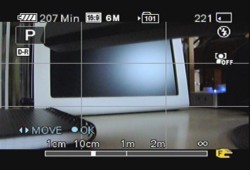
Manual Focus Controls. Use the arrow keys to focus and press OK to confirm.
Dave made some extensive notes on his Movie recording. "These look really good. I shot video in each of the four modes of Charlotte and her Frisbee, and I thought they looked pretty darn good. Much more detail in 1080i vids than from the Panasonic GH1 at that resolution. Sony must be using a much better codec. The data rate is showing as about 13 Mb/s, whereas I'm pretty sure that the GH1 was running AVCHD at 17 Mb/s, but I think the Sony HX1 videos hold together much better. And the files are much smaller, to boot. 720p is likewise very nice, but even the 1080i in "Fine" mode produces reasonably small files. (~14MB/10 seconds of shooting Charlotte running over a very textured surface.)"
Sony makes it very easy to immediately enjoy your images on your HDTV. If you shot 16:9 aspect ratio images, they'll fill the screen in landscape mode. And HD movies will, too. They looked and sounded great, especially when presented by the onboard slide show software.
Even in those first shots, it was remarkable that the HX1 fixated on ISO 125. In bright sun, you get shutter speeds in four digits with an aperture that is a stop or two from fully closed down (or open, for that matter). That keeps the subject still, certainly.
I've never been a fan of high ISO shooting (you know, above ISO 400) on Sony digicams. Sony has always indulged its love of color over detail. Recently, though, I've noticed more detail in Sony digicams at high ISO. The HX1, however, avoids raising the ISO, so unless you do it yourself as I did shooting at ISO 3,200, this comes up less than it usually does.
Even so, detail in the low ISO shots are a little disappointing. The color is pleasant but if you zoom in very close, the image breaks up. You do see some chromatic aberration not uncommon on extreme optics like a 20x zoom, if a bit less than usual. But the lack of small detail on this CMOS sensor is surprising.
I wasn't happy with either color or detail at ISO 3,200, but I can't really complain about it either. It's remarkable to be able to shoot at ISO 3,200. The real issue is what happens at ISO 800. Our test results can't be argued with but my experience may prove illuminating.
In trying out the Handheld Twilight mode, I shot some jasmine by a bench at night. Not much illumination. I shot it three ways: with HT mode, in Programmed Auto with Auto ISO and in Programmed Auto at ISO 800. HT mode took its six shots at ISO 1,250, with no fear of high ISO noise because it had six shots of data for every pixel in the final. Auto ISO dared to slip up to ISO 400 from that sticky ISO 125 the HX1 prefers. So in near darkness, the HX1 only dares to go as high as ISO 400. My ISO 800 shot was not obviously worse as far as noise went, if a little sharper. None of the shutter speeds were reasonable (1/8, 1/3, and 1/5 second).
The HT shot had noticeably less noise. And it was surprisingly sharp considering its multiple shots were taken hand held.
There are two other sets of HT shots in the gallery. One is a close-up of the back of a dSLR. Since it's a dark subject (under a table lamp), you do see plenty of noise on the black body at ISO 400 that just doesn't appear in the HT shot, which is not as sharp but surprisingly sharp all the same, considering, again, it was a series of shots hand held at 1/30 second.
The next trick was a very dark shot of a water faucet. The HT shot used ISO 3,200 (again unafraid of the noise) and put together the set of images in a much sharper final than the Programmed Auto shot (at a brave ISO 500 with a one second exposure), which blurred from camera shake.
HT works. And I'm going to miss it on other digicams. Very much.
My second outing was a walk around Noe Valley in San Francisco. From Castro and 24th, you can peer up at Twin Peaks. And with Precision digital zoom, you can practically stand on Twin Peaks. It's quite a range.
I did get one bird on that walk and some bougainvillea. But what strikes me about the images is the color. It's quite natural, faithful to the original. There is one shot of architectural detail (see YDSC00056.JPG at left) that illustrates that very well. The blue doesn't radiate. It's subtle. And the white banister is not blown out.
In fact, Sony continues to do an excellent job with dynamic range. Since the first Bionz image processors and Dynamic Range Optimization, I've been impressed with how Sony digicams handle dynamic range. It's common to see highlights simply blown out and shadow detail submerged. But not with DRO.
To illustrate that I took three shots of Andy Goldsworthy's Spire in the Presidio.
The three shots were taken with the sun directly behind the stand of felled trees, so contrast was very high. In the first shot (YDSC00158.JPG), DRO is off. In the second (YDSC00159.JPG), it's on. And in the third (YDSC00160.JPG), DRO+ is on. I find that while you pick up a lot of detail in the shadows with the DRO+ image, the sky starts to lose color. With no DRO (like any digicam), there's a nice sky but no detail in the shadows, which is the entire Spire. The best results were clearly the DRO image, which maintained the blue sky while holding onto some detail in the Spire.
And that's really the trick. Extending the dynamic range of the image. DRO does that better than any competing technology I've used (i-Contrast on Canon's or D-Lighting on the Nikons).
And it's one reason I never missed not having a Raw capture on the HX1. On the Kodak, it was a nice idea but not well implemented. On the Canon it was well implemented but, like all Raw processing, not very efficient. So I preferred shooting JPEGs with DRO on the HX1. I got the dynamic range I wanted without all the work.
Another fun aspect of the HX1 is the number of aspect ratios Sony provides. There's 4:3, of course, for the highest resolution (as well as lower resolutions, but there's also 3:2 (like your dSLR) and 16:9 (for widescreen stills). And the 16:9 comes in a high and low resolution version. A press of the Menu button in Shooting mode quickly gets you to the image size options to select between them, too.
I confess to having some trouble with the Menu button. In some cases it wasn't responsive. In others, it just baled on me, returning to Shooting mode. It shouldn't do that and if I'd bought this HX1, I would have returned it for a functioning model.
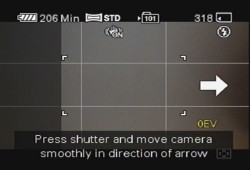
Sweep Panorama. Note the dark gray area on left won't be included. Note also the white arrow for direction.
But back to the fun of aspect ratios. They're not only for stills, of course. You can shoot 16:9 movies or 4:3 movies. And you can use them for shooting Sweep Panoramas, too.
Sweep Panoramas are fun, no question. You just set the Mode dial to Panorama, line up the starting edge of your composition, press the Shutter button (hold it) and sweep in the direction of the on-screen arrow in a full, tight arc. Image size (aspect ratio) and sweep direction can be changed by pressing the Menu button.
The trouble I had with this mode was getting from one end of the pano to the other. You only have a certain amount of time and the camera only records a certain arc, which turned out to be more than I wanted most of the time. If you take too long, you get a gray bar on the unfinished end. If you quit too early, a black one. Or something like that. Keep sweeping until the shot finishes. That's my advice.
That's a more natural way to take a pano than most cameras offer. Stitch-assist modes tend to show a bit of the last still so you can align things and that's about it. You take a series of stills and some cameras (Kodak, for example) stitches the still together in the camera while others (Canon) require you to do it on the computer using software supplied on CD.
I found the stitch is, predictably, not always (or even usually) perfect. But it's a lot of fun anyway. One reason is that in Playback mode, you can fill the screen with the height of the image and have it scroll the width of the image (for a landscape pano). That's a kick, especially if you're watching it on an HDTV.


No comments:
Post a Comment